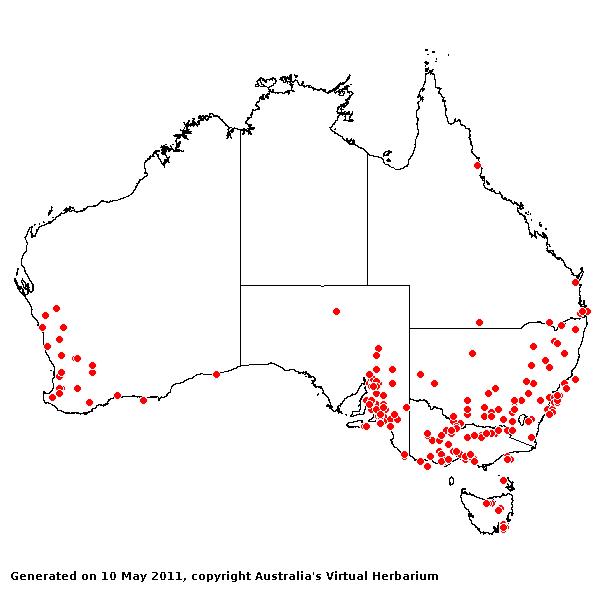Phalaris minor* Retz. Obs. Bot 3:
8 (1783).
Classification. (GPWG 2001) : Subfamily Pooideae.
Tribe Poeae.
Type of Basionym or
Protologue Information: T: Anon., Oriente (LD-89/31.1962). LT
designated by Baldini, Webbia 47(1): ? (1993).
Key references
(books and floras): [1878] G.Bentham, Flora Australiensis 7 (556),
[1952] C.A.Gardner, Flora of Western Australia 1 Gramineae (23),
[2002] D.Sharp & B.K.Simon, AusGrass, Grasses of Australia, [2002]
J.Wheeler, N.Marchant & M.Lewington, Flora of the South West (428), [2006]
J.Jessop, G.R.M.Dashorst, F.M.James, Grasses of South Australia (242),
[2008] S.W.L.Jacobs, R.D.B.Walley & D.J.B.Wheeler, Grasses of New South
Wales (339), [2009] A.Wilson (ed.). Flora of Australia, Vol 44A. Poaceae
2 (149).
Illustrations:
[1952] C.A.Gardner, Flora of Western Australia 1 Gramineae (24
& 25, Pl. 4 & 5), [2006] J.Jessop, G.R.M.Dashorst, F.M.James, Grasses
of South Australia (242, Fig. 186),
[2008] S.W.L.Jacobs, R.D.B.Whalley & D.J.B.Wheeler, Grasses of New South
Wales, 4th edn (339).
Habit. Annual.
Culms erect or geniculately ascending, stature robust to moderate or slender to
delicate, 5–103 cm tall, 3–10 -noded. Ligule an eciliate membrane, 2–7.5 mm
long, entire. Leaf-blades 4.8–27.5 cm long, 3–13 mm wide.
Inflorescence.
Inflorescence solid, a panicle. Panicle oblong or ovate, 1–9 cm long, 1–2 cm wide.
Spikelets.
Spikelets pedicelled. Fertile spikelets 1 or more flowered, with 1 fertile
floret, comprising 2 basal sterile florets, comprising 1 fertile floret(s),
without rachilla extension, elliptic, laterally compressed, 4–6.5 mm long.
Glumes. Glumes
similar, thinner than fertile lemma. Lower glume elliptic, chartaceous, keeled,
1-keeled, winged on keel, winged moderately, 3 -nerved. Lower glume apex
muticous. Upper glume elliptic, 4–6.5 mm long, chartaceous, keeled, 1-keeled,
winged on keel, 3 -nerved. Florets. Basal sterile florets 2 or more.
Lemma of upper sterile floret 1–1.8 mm long.
Fertile lemma 2.4–4 mm
long, keeled, 5 -nerved. Lemma surface indumented. Palea 1–2 -nerved, without
keels. Anthers 3. Grain 2.3–2.5 mm long.
Continental Distribution:
Europe, Africa, Temperate Asia, Tropical Asia, Australasia, Pacific, North
America, South America, and Antarctica.
Australian
Distribution: Western Australia, South Australia, Queensland, New South
Wales, Victoria, Tasmania, Norfolk I.
Western Australia:
Drummond. South Australia: Lake Eyre, Flinders Ranges, Eastern, Eyre
Peninsula, Northern Lofty, Murray, Yorke Peninsula, Southern Lofty, Kangaroo
Island, South-eastern. Queensland: Cook, Moreton, Warrego, Wide Bay. New
South Wales: North Coast, Central Coast, South Coast, North-Western Slopes,
Central-Western Slopes, South-Western Slopes, North-Western Plains,
South-Western Plains, North Far Western Plains, South Far Western Plains. Victoria:
East Gippsland, Eastern Highlands, Gippsland Plain, Lowan Mallee, Midlands,
Murray Mallee, Otway Plain, Otway Range, Riverina, Volcanic Plain, Wannon,
Wimmera. Tasmania: North West, East Coast.
Notes.
Grown for forage and seed, widespread as an escape from cultivation.
Introduced.
All states and territories except N.T. Introduced and naturalised in many
temperate regions, but native to the Mediterranean. A weed of cultivation and
disturbed areas, often in moist habitats. Flowers Aug.-Jan. Fruits Oct.-Mar.




